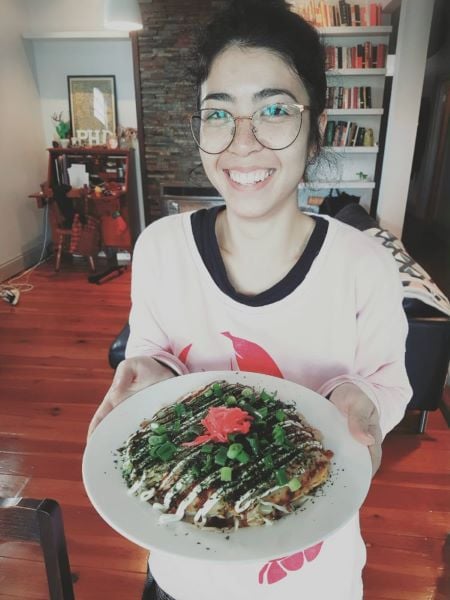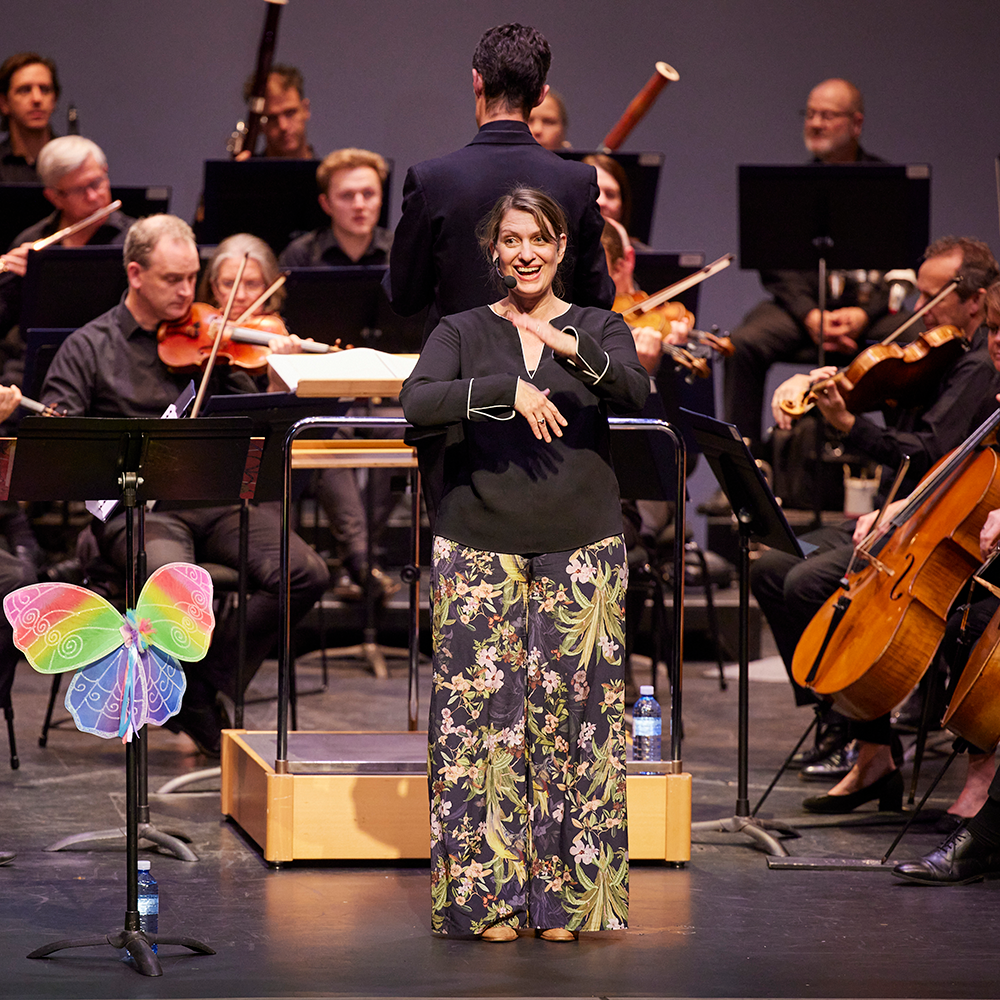ASO in the Kitchen Emma Gregan
- Musician Spotlight

ASO’s French Horn Emma Gregan loves how food, like music, brings people together and finds it both meditative and creative. She’s not a stickler for following the recipe and often uses her intuition and goes with the flow in the kitchen. Emma prefers savoury to sweet and loves the simplicity and freshness of Japanese cuisine, so why not find some time and try making her Japanese savoury pancake.
You’re a foodie and a fab cook. What/who inspired your love of cooking and sharing your goodies with the orchestra?
I’m not sure if I’m very good at cooking but I do like eating! I think food, like music, is a great way of bringing people together.
People often find solace in cooking and eating. Is that the case for you, and did you find yourself baking more whilst we were in COVID-19 isolation?
I’m cooking a lot more at home now that I’m spending more time here. Normally I’m on the run a lot but now I have time to try out some recipes I haven’t got around to for a long time. There are a few recipes I’m trying to improve on too. I don’t mind baking sweets, but I prefer working with savoury things as I find them a bit more intuitive.
What do you love about cooking?
I think it can be quite a meditative thing to do because it forces you to focus on doing small repetitive tasks properly and with intent. I’m not someone that likes to stick to the letter of a recipe so it can also be a nice creative exercise too if, like me, you like to throw caution to the wind now and then!
Is there cooking rivalry in the orchestra? Who would be the head chef and why?
I think Simon Cobcroft should be the head chef, everyone knows the food he makes is delicious and he’s very patient in cooking things that take days to prepare. Shirin should be in charge of menu planning and large-scale catering because I’ve never known anyone to go hungry at Shirin’s parties. Lachlan makes wonderful cakes so he could be the dessert chef!
What is your favourite recipe that you love to cook, and why?
My favourite thing to cook at home is okonomiyaki. It’s a Japanese savoury pancake sort of thing, and there is a strong rivalry in Japan between the Osaka-style and the Hiroshima-style. I always make it Hiroshima-style because my family is from Hiroshima Prefecture. I grew up eating beautiful Japanese food made by my mum so even though I was born and raised in Australia it feels very homely to me to eat Japanese food.
What food do you cook that your family requests the most?
My partner seems to like the okonomiyaki I make, but if I’m back in Brisbane with mum and dad I’m usually the one doing the requesting because my mum is a wonderful cook.
Do you have any cooking tips or secrets?
I think this is probably bad advice, but I think it’s nice not to follow recipes too closely, otherwise I think it stops you from thinking about and observing how things go together. I guess if you’re making a complicated dessert you should probably follow the recipe pretty carefully (this is usually where I go terribly wrong) but I think it’s good to experiment a little, with the savoury things especially.
Describe your last supper. What would be on the menu and who would be at the dinner table?
I quite enjoy those chaotic meals where everyone brings something they’ve made themselves and nothing necessarily goes together but it all tastes great anyway. I’d like to have as many of my friends, colleagues, and family there as we could fit around the table: the more the merrier.
What music do you like to listen to when you are cooking?
Something reasonably loud and energetic if possible, especially because I need to be able to hear it over the various sounds of chopping vegetables and clattering kitchenware. Opera or music for brass are good choices!
What is your favourite cuisine?
I don’t have a clear favourite but if I had to choose it would be Japanese. There’s a lot of variety and it’s healthy so I’d be quite happy to eat it every day if I could. I’m a big seafood fan, especially raw, so that’s a big bonus of Japanese cuisine too.
My favourite South Australian restaurant or café is… (and why I love it)
At the moment I’m desperate to go back to Urumqi on Gouger St. The food is remarkably cheap and delicious. I think their fried long beans are the best I’ve tried, and the eggplant is amazing too. I’ve found you can order one gigantic long noodle that fills up a whole plate or a noodle that’s been cut into tiny cubes the size of corn kernels. Either way, they’re very tasty.
Favourite takeaway?
Pizza, not just because it’s delicious and filling, but because they’ve sorted out the takeaway logistics, like the cardboard boxes you can compost. Also, you can get pizza until about 1 am in Adelaide, which can’t be said for most things, so pizza has been there for me through some post-concert hunger spells.
Sweet or savoury?
Both, but savoury at a stretch!
What recipe would you like to share?
Here’s a good recipe I like that also introduces a few essential Japanese ingredients, like Okonomiyaki sauce, which is the Japanese version of barbecue/Worcestershire sauce. We usually skip the pork at home and use udon noodles and shredded cheese too, which is a modern variation. You can get these ingredients at a good Asian grocery store, or Little Tokyo in the Central Markets which has a good variety of imported Japanese ingredients.
Hiroshima-Style Okonomiyaki 広島風お好み焼
Recipe courtesy of Justonecookbook.com
Hiroshima-style Okonomiyaki is a Japanese savoury pancake with cabbage, bean sprouts, noodles, sliced pork belly and a fried egg, topped with savoury sauce and Japanese mayo.
Ingredients
150 ml water (a little bit less than ⅔ cup)
1 tsp mirin
100 g plain flour (between ¾ cup to 1 cup; Usually, cake flour is used for Okonomiyaki, but you can use plain flour since it’s more readily available.)
240 g cabbage (about 3 large cabbage leaves)
1 green onion/scallion
2 tbsp katsuobushi (dried bonito flakes)
4 tbsp Tenkasu/Agedama (tempura scraps)
60 g bean sprouts (about a handful)
2 tbsp Tororo Kombu (optional; you can buy online)
6 slices sliced pork belly
2 Yakisoba Noodles
2 large eggs
Toppings
Okonomiyaki sauce (make a homemade Okonomiyaki sauce or find at an Asian grocery store)
Japanese mayonnaise
Aonori (dried green seaweed)
Pickled red ginger (beni shoga or kizami beni shoga) (optional)
Method
In a large bowl, add water and mirin.
Add the flour and whisk until combined. Chill the batter for at least 1 hour in the refrigerator so the texture will become smooth.
Meanwhile, cut the cabbage and scallion into thin slices. A good sharp knife will help you cut the cabbage into thin slices.
Grind katsuobushi in a mortar and pestle until it becomes a fine powder.
After chilling in the refrigerator, the batter becomes smooth.
Make one Okonomiyaki at a time (unless you are comfortable making two at the same time). Keep in mind the ingredients are for 2 serving so divide all the ingredients into two equal parts.
Heat a large non-stick griddle to 170 °C. Pour about ¼ cup of the batter onto the hot griddle. Immediately using the back of the ladle, move the ladle in a spiral motion from the centre towards the edge of the batter, spreading like a crepe. This process will make the batter thin out and maintain the nice round shape. The width of “crepe” should be about 20-23 cm.
Sprinkle ground katsuobushi on the batter and place cabbage on top.
Next put tenkasu, scallion, and bean sprout on top.
Then put tororo kombu (optional) and 3 slices of thinly sliced pork belly without overlapping.
Pour 1 tbsp batter on top (this will act as glue). Using two spatulas one on each side, carefully and quickly flip. Turn the heat to 200 °C to cook the meat. Don’t press down the “crepe” with the spatula yet (you will do it later). When the pork belly is no longer pink, turn the heat down to 170 °C and move the Okonomiyaki to the side. If you are using a frying pan instead of the griddle, start heating another frying pan.
Separate the noodles with hands and place them in the open space on the griddle (or the 2nd frying pan). Stir fry the noodles until they are coated with oil. Add 1-2 tbsp okonomi sauce and coat with the noodles.
Make the noodles into a round shape similar to the same size as the ‘crepe’. Now using two spatulas, transfer the Okonomiyaki on top of the noodles.
Heat the oil in the open space and crack an egg. Quickly spread the egg into the same size as Okonomiyaki.
Before the egg is completely cooked, place the Okonomiyaki on top of the egg
When the bottom of the egg is cooked, using the two spatulas, flip the Okonomiyaki for the last time. Season with okonomi sauce, mayonnaise, and aonori. Serve immediately.




